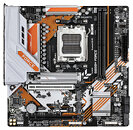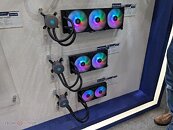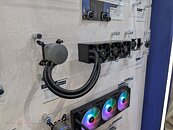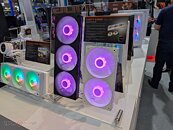
Gigabyte Launches B850M Force microATX Motherboards, Reviving Orange Force Series for AMD AM5 Processors
GIGABYTE has a little surprise as it just listed a new B850 motherboard on its website, named B850M Force. This standard microATX form-factor AM5 motherboard marks the return of GIGABYTE's SOC Force series (i.e., GA-Z170X-SOC Force or GA-Z97X-SOC Force) that "eons ago" delighted Intel users with its striking orange aesthetics. Going from the cold, full white designs of its B850 Ice motherboards such as B850 Aorus Stealth Ice or B850M Eagle Ice series launched in January, this newly launched Force motherboard series packs a complete set of features tailored for a variety of users as well as retro enthusiasts from the Intel Z97 and Z170 times a decade ago.
The GIGABYTE B850 Force microATX motherboard is built around AMD's B850 chipset and supports the full range of AMD Ryzen processors for the AM5 socket, including the latest 9000 series CPUs. The board has an 8+2+2 phase digital VRM with heatsinks and supports up to 128 GB of DDR5 memory across two DIMM slots, with speeds up to overclocked 9600 MT/s (including AMD EXPO and XMP profiles). Storage connectivity consists of three M.2 slots supporting different PCIe configurations alongside four SATA 6 Gb/s connectors. Expansion capabilities include a PCIe x16 slot that supports PCIe 5.0 and an additional PCIe x4 slot from the chipset. Connectivity features include integrated Wi-Fi 6E with Bluetooth 5.3 (for the Wi-Fi 6E model), a 2.5 Gigabit Ethernet controller, and multiple USB ports including USB 3.2 Gen 2 and USB-C connections. Alongside its orange appearance, the motherboard has another surprise: a PS/2 port for those who are truly into the retro theme. Display outputs consist of HDMI 2.1 supporting 4K at 60 Hz and DisplayPort 1.4 capable of 4K at 144 Hz (depending on the iGPU capabilities of the installed processor).
The GIGABYTE B850 Force microATX motherboard is built around AMD's B850 chipset and supports the full range of AMD Ryzen processors for the AM5 socket, including the latest 9000 series CPUs. The board has an 8+2+2 phase digital VRM with heatsinks and supports up to 128 GB of DDR5 memory across two DIMM slots, with speeds up to overclocked 9600 MT/s (including AMD EXPO and XMP profiles). Storage connectivity consists of three M.2 slots supporting different PCIe configurations alongside four SATA 6 Gb/s connectors. Expansion capabilities include a PCIe x16 slot that supports PCIe 5.0 and an additional PCIe x4 slot from the chipset. Connectivity features include integrated Wi-Fi 6E with Bluetooth 5.3 (for the Wi-Fi 6E model), a 2.5 Gigabit Ethernet controller, and multiple USB ports including USB 3.2 Gen 2 and USB-C connections. Alongside its orange appearance, the motherboard has another surprise: a PS/2 port for those who are truly into the retro theme. Display outputs consist of HDMI 2.1 supporting 4K at 60 Hz and DisplayPort 1.4 capable of 4K at 144 Hz (depending on the iGPU capabilities of the installed processor).
























































































